This article is a prelude to the upcoming digital seminar on Understanding Threats and Mitigating Risks for food service businesses. Register here.
It takes a lot to run a successful restaurant. On top of the daily challenges of simply meeting the bottom line, food service businesses big and small face a laundry list of security threats that can affect that bottom line as well.
Cyber security, ransomware, POS malware, food supply chain safety, property theft, disaster recovery, and other concerns present unique challenges for both preparedness and response. But according to recent studies, the far-reaching effects and costs associated with one potential threat fly under the radar compared to other common business risks: workplace violence—or WPV.
As of November 28, 2022, there have been 610 mass shootings in the United States this year, many in and around food service businesses and the neighborhoods they serve. These incidents highlight the threats that restaurants and all hospitality businesses need to be aware of to protect their employees from workplace violence.
Just recently, 888 companies were surveyed about the top threats that their organizations were preparing for. 69% said “active shooter” and 62% said “workplace violence”. (Everbridge and EMS Solutions Active Shooter Preparedness Survey.)
Every year in America, more than 2 million workers become victims of workplace violence. Nearly half of HR pros say their company has experienced a WPV incident, and businesses face more than 16,000 threats per day. Restaurant and hospitality workers have been on the front lines since the beginning of the pandemic and have been increasingly vulnerable to the risk of violence, potentially exacerbated by the current stressors, such as health concerns and economic uncertainty.
Yet despite both the frequency and seriousness of WPV risks, many businesses are still unprepared. A survey from the Society of Human Resource Management (SHRM) revealed that less than half of organizations have a program to prevent workplace violence or provide training to workers on how to respond to an act of workplace violence. Nearly one-third of workers (29%) said that they are unsure or don’t know what to do if they witness or are involved in workplace violence. And 1 in 7 workers feel unsafe at work.
Apart from the obvious consequences—loss of life, injuries, and property damage—a lack of preparation for such an incident can have tremendous consequences and costs.
What kind of costs? Forbes states that, annually, businesses lose somewhere in the neighborhood of $250-330 billion due to WPV. In addition to the fallout listed above, the extended effects can be devastating. Litigation, survivor counseling, rehabilitation of a company’s reputation and more all carry costs that can severely damage the bottom line.
As restaurant owners and managers, it is your responsibility to ensure a safe environment for your employees and patrons.
While threats may be unavoidable, preparedness offers a much more positive outlook when potential WPV risk arises. Not only can it help protect employees and company assets from harm, statistics show that the cost of prevention is 100 times less than the cost of managing the aftermath of a tragedy. In short, WPV preparedness saves lives and money.
The best time to develop a workplace violence prevention program is before you need one.
RLPSA has partnered with The Power of Preparedness (TPOP) to offer a 5-part webinar series to help you understand the threats and to optimize protection of your employees, guests, and assets. The first event is December 8 and you can register here.
